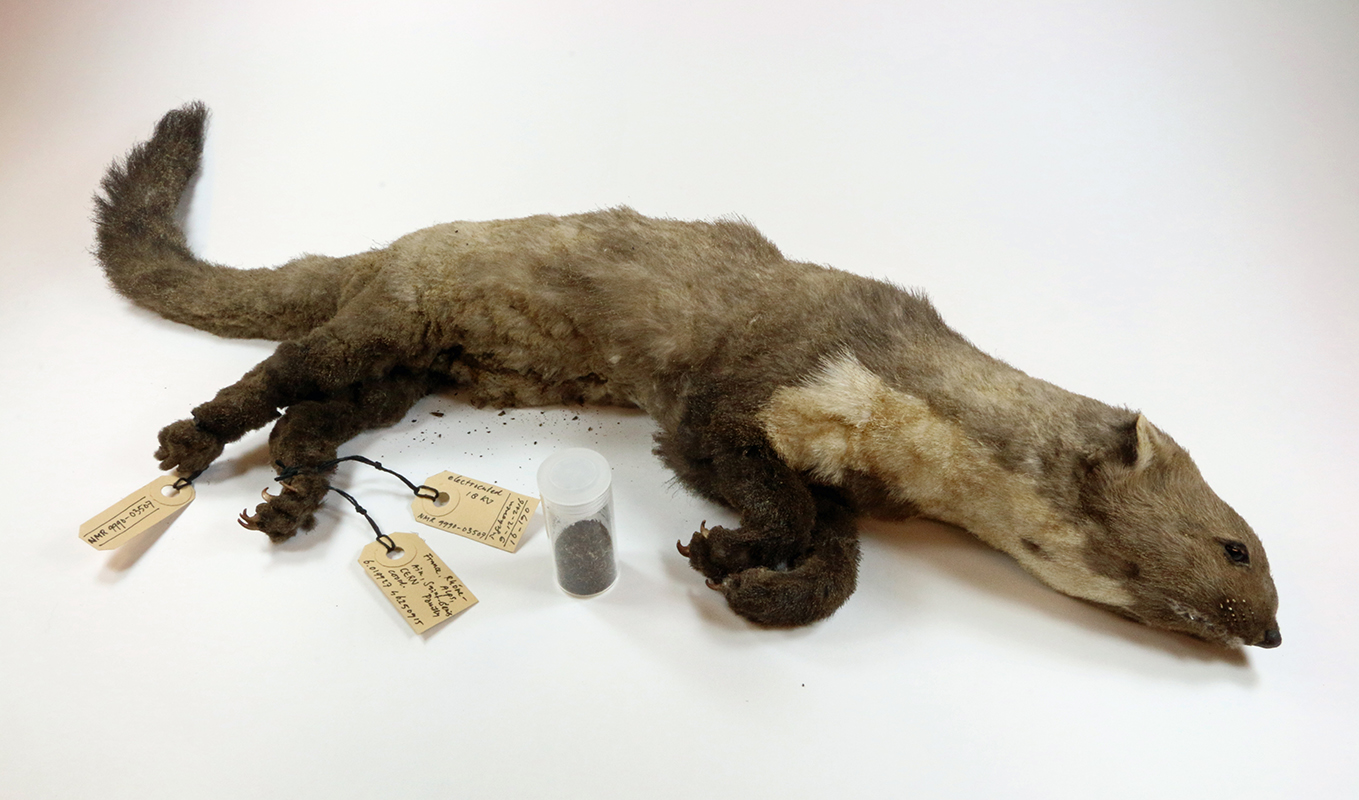Animal Electrocuted at Atom Smasher Gets New 'Life' in Morbid Exhibit

Deceased animals in a range of compromising poses share cautionary stories of times when wildlife interactions with humans turned deadly — for the wildlife — in the unusual exhibit "Dead Animal Tales" at the Natural History Museum Rotterdam (NHMR) in the Netherlands.
Recently, NHMR welcomed a new addition to the exhibit: a stone marten (Martes foina) that met its end Nov. 20, 2016, after it bumbled its way into a substation at the European Organization for Nuclear Research (CERN) in Geneva, Switzerland.
The marten — known as "CERN 'weasel' 2" — jumped a fence and was instantly electrocuted when it encountered an 18,000-volt transformer. The incident interrupted power to part of CERN's particle accelerator, called the Large Hadron Collider (LHC), NHMR representatives said in a statement. [See Photos of Lake Animals 'Turned to Stone']
Not many exhibits can say they began with homosexual duck necrophilia — but this one can. The specimen that launched "Dead Animal Tales" was a mallard that suffered a fatal collision with a window at the museum in 1995. Almost immediately afterward, another mallard approached and began having sex with the dead bird.
Exhibit curator and NHMR director Kees Moeliker wrote a study about the highly unusual behavior, which earned him the Ig Nobel Prize — an award for thoughtful research that also inspires laughter — in 2003.
"Thanks to the Ig Nobel Prize that my First-Case-of-Homosexual-Necrophilia-Paper won, the story of that poor bird became widely known and people wanted to see and admire the duck," Moeliker told Live Science in an email.
In 2005, after the museum acquired "Domino Sparrow" — a bird that was shot and killed after it disrupted a competitive domino event by knocking down 23,000 domino tiles — curators had two candidates to inspire a new twist on museum specimens, of which NHMR had 400,000, Moeliker said.
Get the world’s most fascinating discoveries delivered straight to your inbox.
Other animals that died under similarly peculiar circumstances were donated over the years, and today, that first dead duck has plenty of company. In fact, "Dead Animal Tales" is one of the museum's most popular exhibits, Moeliker told Live Science.
A fate worse than death
The exhibit's unlucky inhabitants met their demises in different unpleasant ways. But every specimen represents a circumstance in which some type of human activity shortened its life. [Gallery: Freeze-Dried Pets]
"Salty Snack Mouse," a 10-day-old house mouse, was donated to the exhibit in 2012, after it was discovered in a bowl along with the contents of a bag of salty snacks. Such a young mouse would be physically unable to climb into a bowl, so it likely was already in the bag and was poured into the bowl along with the snacks, according to a NHMR statement.
The tapering lid of a McDonald's ice-cream container caused the sticky end of "McFlurry Hedgehog" in 2007. The hapless, hungry hedgehog wedged its head inside the cup, looking for leftover ice cream, but its spines prevented it from pulling back out.
"Trauma Gull" was a traffic victim, a black-headed gull that expired after a midair head-on collision with a flying trauma helicopter in 2011. The force of the impact knocked a hole in the cockpit, and the pilot was forced to make an emergency landing after securing the hole with duct tape.
Singed and charred
The latest specimen to join the exhibit, "CERN 'weasel' 2," was so named because it was the second weasel-like mammal to fry itself to death at CERN. The first, a stone marten that short-circuited a transformer in April 2016, shut down the LHC for close to two weeks, CERN officials reported.
However, that animal's body was destroyed at CERN before NHMR curators could collect it. They were luckier after the November incident, recovering a female that measured about 2.3 feet (70 centimeters) in length, with scorched whiskers and fur, and charred soles and skin on its legs, NHMR representatives explained in a statement.
And the exhibit will likely continue to grow, as Moeliker frequently fields queries from people offering him dead animals, victims of the sometimes lethal collisions between animal and human lives.
"Today, I got a phone call from somebody who found a mummified turtle in a wash dryer. Their pet was lost for six years," he told Live Science.
The exhibit "Dead Animal Tales" is on permanent display at the Natural History Museum Rotterdam.
Original article on Live Science.

Mindy Weisberger is a science journalist and author of "Rise of the Zombie Bugs: The Surprising Science of Parasitic Mind-Control" (Hopkins Press). She formerly edited for Scholastic and was a channel editor and senior writer for Live Science. She has reported on general science, covering climate change, paleontology, biology and space. Mindy studied film at Columbia University; prior to LS, she produced, wrote and directed media for the American Museum of Natural History in NYC. Her videos about dinosaurs, astrophysics, biodiversity and evolution appear in museums and science centers worldwide, earning awards such as the CINE Golden Eagle and the Communicator Award of Excellence. Her writing has also appeared in Scientific American, The Washington Post, How It Works Magazine and CNN.



